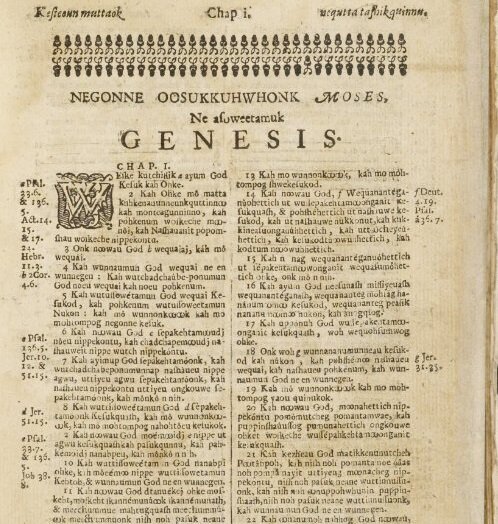
Indigenous converts in seventeenth-century Natick adapted Mosaic Law to preserve some political power under English colonial rule.
Indigenous converts and leaders adopted these rules in Concord in 1646. Converts continued to follow these rules in Natick. They are similar to the Ten Commandments found in the Old Testament. Source: The Eliot Tracts: With Letters from John Eliot to Thomas Thorowgood and Richard Baxter, pg. 115
Politics in Early Natick: Mosaic Law
The Puritan Missionary John Eliot established Natick as a “Praying Town” where Indigenous converts lived under Old Testament Mosaic Law. However, Natick’s early Indigenous residents interpreted Mosaic Law in ways that helped them preserve some political power under English colonial rule. Their interpretations of Mosaic Law highlight the dynamic political culture of early Natick.
John Eliot was a Puritan and a millennialist. He believed that Jesus would one day reign over the earth for a thousand-year period. To prepare, Eliot thought that people needed to follow Mosaic Law, the legal and social practices described in the Old Testament. He saw “Praying Towns” as enclaves of Mosaic Law. He also believed that the only path to complete conversion for Indigenous people meant living according to rules from the Bible, including following Mosaic Law.
During the first decades of Natick’s history, the town’s political structure consisted of elected rulers of tens, rulers of fifties, and a ruler of one hundred. This system was based on instructions from the Book of Exodus. The rulers enforced strict legal and social codes requiring residents to follow English expectations for marriage, gendered work, dress, religious beliefs, and ceremony.
On August 6, 1651, the male converts in Natick elected their rulers. Totherswamp, Natous, Peter, Piambouhou, and Thomas Speen were among the ten men who became rulers of ten. Waban and another man became rulers of fifty. Cutshamekin became the ruler of a hundred. Each man in Natick chose which ruler of ten their family followed. On September 24, 1651, during a day of fasting and prayer, the rulers pledged themselves to Christianity through a civil covenant. To John Eliot, this covenant was an eternally binding agreement with God that signaled the beginning of Natick as a polity.
Indigenous converts and leaders adopted these rules in Concord in 1646. Converts continued to follow these rules in Natick. They are similar to Ten Commandments found in the Old Testament. Source: The Eliot Tracts: With Letters from John Eliot to Thomas Thorowgood and Richard Baxter pg. 116
The Indigenous residents of Natick used Mosaic Law to maintain aspects of their pre-existing political systems. The structure of numerical leaders was similar to the sachemship governance system in Massachusett and Nipmuc communities. According to Massachusett and Nipmuc politics, many elected rulers in Natick already held hereditary political power. For example, Cutshamakin, the hereditary grand sachem of the Neponset Massachusett, became “chief ruler” in Natick. Some historians argue that tithing practices in Natick also resembled Massachusett and Nipmuc tribute systems. These similarities may have encouraged some hereditary leaders to move to Natick.
Although Mosaic Law and millennialism were controversial under English secular law, Indigenous rulers in Natick were considered legitimate by English authorities. Natick’s rulers used their positions to gain protection under colonial rule. They enacted legal justice and punishment for petty crimes in Natick and other “Praying Towns.” The rulers had to turn more serious cases over to non-Indigenous magistrates and the Indian Superintendent, Daniel Gookin.
As residents of Natick returned to the community after King Philip’s War, Mosaic Law remained in place to some degree. Waban’s son, Thomas Waban, ruled a hundred. A seventeenth-century visitor to Natick described him as a “king” or “sachem.” The visitor also described a female relative of Waban ruling with him as a “queen.” It is possible that after the war, the political system changed to more fully incorporate Indigenous political practices and gender norms.
By 1707, Natick had adopted the same political system as other towns in Massachusetts. A board of selectmen replaced the numerical leaders. The residents of Natick may have believed it would serve their community’s needs better than Mosaic Law at that time. During the board of selectmen’s first years, and as more English settlers moved to Natick, only Indigenous people could serve as selectmen. Over the course of the mid and late-eighteenth century English settlers in Natick took over those roles.
by Gail Coughlin
To read more about the history of the Nipmuc Nation and the Massachusett Nation, please visit their websites here: The Nipmuc Nation, The Massachusett Nation.
Selected sources and additional reading:
Natick Historical Society collections.
Cogley, Richard W. John Eliot’s Mission to the Indians before King Philip’s War. Cambridge: Harvard University Press, 1999.
Morley, James W. From Many Backgrounds: The Heritage of the Eliot Church of South Natick. South Natick, MA: The Natick Historical Society, 2007.
O’Brien, Jean M. “Community Dynamics in the Indian-English Town of Natick, Massachusetts, 1650-1790.” PhD diss. University of Chicago, 1990.
O’Brien, Jean M. Dispossession by Degrees: Indian Land and Identity in Natick, Massachusetts, 1650-1790. Cambridge: Cambridge University Press, 1997.


